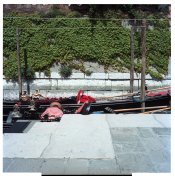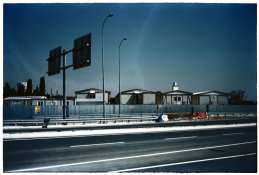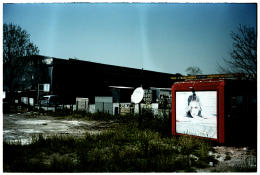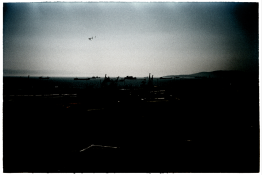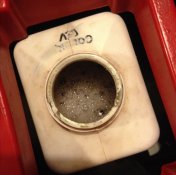Hello,
I've been searching for some answers to my new endeavour: color developing (soon to be followed by RA-4 printing) and found some useful information but nothing that answered my questions directly. Let's start with the most aggravating issue:
Please have a look at this picture. I modified in Photoshop to try to bring out the issue more clearly. As you can see there are some "foam" looking density variations. These only appear on some frames and not all. I have noticed it in both 35mm and medium format, but as I said, they are not on all frames of the same film (as far as I have noticed).

Here is the processing for this image:
5mn dry pre heat as per JOBO instructions,
Jobo CPP2 on "P" agitation setting,
38C @ 3:15,
Stabiliser: 2 drops in 700ml of water, gentle hand agitation,
Hung to dry at room temperature.
These are very hard to see with the naked eye, but on this particular negative I could see it. There are no residues on either side of the negative.
Tetenal customer service did not get back to me, but a very nice gentleman from Jobo helped me. I am now looking for your opinion and experiences as to what you think causes this.
General questions:
1) the manual indicates different times depending on the number of films, 3:15 from 1 to 4 films, 3:30 from 5 to 8 and so on. If I want to do 8 films at once with fresh chemicals, I use the 3:30 times? For 10 films I would use the 9 to 12 films times (3:45), correct?
2) how do I compensate chemical exhaustion when mixing film speeds? It seem that a 400ASA speed film uses about 30% more chemicals, so do I count one roll of 400ASA as 1,3 roll of 200ASA? Meaning, out of 16 films per liter, I could wash 6x400ASA and 6x200ASA? How about the older 800ASA speed films?
3) there might be a chance for me to do some special developing for some local photographers. I want to provide the best quality possible. Locally I only have access to Tetenal but I travel to Europe from time to time and could get the Rollei kit. Should I bother or is proper developing technique more important than chemical brands for quality?
Looking forward to your input!
m.
I've been searching for some answers to my new endeavour: color developing (soon to be followed by RA-4 printing) and found some useful information but nothing that answered my questions directly. Let's start with the most aggravating issue:
Please have a look at this picture. I modified in Photoshop to try to bring out the issue more clearly. As you can see there are some "foam" looking density variations. These only appear on some frames and not all. I have noticed it in both 35mm and medium format, but as I said, they are not on all frames of the same film (as far as I have noticed).
Here is the processing for this image:
5mn dry pre heat as per JOBO instructions,
Jobo CPP2 on "P" agitation setting,
38C @ 3:15,
Stabiliser: 2 drops in 700ml of water, gentle hand agitation,
Hung to dry at room temperature.
These are very hard to see with the naked eye, but on this particular negative I could see it. There are no residues on either side of the negative.
Tetenal customer service did not get back to me, but a very nice gentleman from Jobo helped me. I am now looking for your opinion and experiences as to what you think causes this.
General questions:
1) the manual indicates different times depending on the number of films, 3:15 from 1 to 4 films, 3:30 from 5 to 8 and so on. If I want to do 8 films at once with fresh chemicals, I use the 3:30 times? For 10 films I would use the 9 to 12 films times (3:45), correct?
2) how do I compensate chemical exhaustion when mixing film speeds? It seem that a 400ASA speed film uses about 30% more chemicals, so do I count one roll of 400ASA as 1,3 roll of 200ASA? Meaning, out of 16 films per liter, I could wash 6x400ASA and 6x200ASA? How about the older 800ASA speed films?
3) there might be a chance for me to do some special developing for some local photographers. I want to provide the best quality possible. Locally I only have access to Tetenal but I travel to Europe from time to time and could get the Rollei kit. Should I bother or is proper developing technique more important than chemical brands for quality?
Looking forward to your input!
m.










 I follow the instructions to the letter. When you say amount of developer tweaking, are you thinking more or less? As I said, I use 1L bottles, though by the end (after 16 films) I must have around 800ml of developer in the bottle.
I follow the instructions to the letter. When you say amount of developer tweaking, are you thinking more or less? As I said, I use 1L bottles, though by the end (after 16 films) I must have around 800ml of developer in the bottle.



